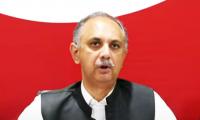KARACHI: Fitch Solutions on Thursday warned Pakistan of larger economic distortions and greater pain in future for seeking unconventional funding sources to avert the balance of payment crisis, and little appetite for austerity and economic reforms.
The credit rating agency, in a report, said Prime Minister Imran Khan's administration continued to seek unconventional sources of funding to prevent a balance of payments crisis, which would typically require a sharp contraction in imports, accompanied by a slowdown in economic activity.
“However, that is just kicking the can down the road in our view, which would create larger economic distortions and greater pain in the future,” the report said.
It forecasted credit growth to slow over the coming months, as the impact of significant tightening by the central bank in 2018 begins to feed through.
The loan growth projection was revised down to 13.0 percent in 2019 from an estimated 15.0 percent in 2018.
Together with higher oil prices, this could also create weaker asset quality, and reduced profitability and capitalisation.
The Pakistani banking sector, however, appears to be on a sound footing for now, the report said, adding that the broader economy and industry would deteriorate over the coming quarters.
“There will likely be a delayed negative effect, as the government continues to postpone much-needed fiscal austerity and economic rebalancing with unconventional methods.”
Fitch Solutions forecasted that the headline metrics across Pakistan’s banking sector would continue to look solid, and push back decline in profitability and asset quality.
Loan growth to the private sector continued to accelerate in November, hitting a fresh multi-year high of 21.4 percent year-on-year, while the non-performing loans (NPLs) ratio remained low in Q318, coming in at 8.0 percent of total loans, only up marginally from the previous quarter’s print of 7.9 percent.
Loans to the private sector have continued to increase as a share of total credit, coming in at 41 percent in November, the highest level since 2013.
With profitability on loans to the private sector much higher than loans to the government, the banking sector’s profitability would likely rebound over the coming quarters after seeing a slump in Q118.
Taken together with the added tailwind of lower oil prices (since Q418) helping to boost consumer purchasing power and corporate margins, “we expect asset quality and capitalisation to remain healthy in the near-term”.
The report stated that the worst-case scenario of a balance of payment crisis appears likely to be avoided in the near-term with foreign bilateral assistance.
Islamabad has secured $3.0 billion in
foreign loans from the UAE, and was eyeing further assistance in the form of deferred oil payments.
The government has also reportedly secured an additional $2.0 billion from Beijing. While the details of the agreement remain murky, the deal appears to be part of the larger China-Pakistan Economic Corridor (CPEC) framework.
“It seems likely that the latest round of Chinese largesse has given Islamabad the
confidence to snub the IMF’s more stringent requirements for obtaining funds. However,
should Pakistan experience acute signs of a
currency crisis over the coming months, we would not be surprised to see talks between
Pakistan and the IMF resume,” Fitch report
said.
The cumulative 400bps interest rate hikes
by the SBP over the course of 2018 could lead to a slowdown in loan growth in the coming months.
With tighter monetary conditions increase refinancing risks could rise, negatively impacting asset quality of banks, it added.
Real benchmark interest rates have increased to around 380 bps as of end-December, which would make loan affordability increasingly difficult in the low margin manufacturing sector that has been the main recipient of the recent surge in credit.
Oil prices would also likely rebound over the coming quarters, posing headwinds to the economy.
“Lastly, we believe that Pakistan’s external woes are not yet over.”
Financial assistance in some form or another should help prevent a destabilising currency collapse and an outright recession in the near-term, which would potentially lead to a surge in NPLs as corporate profitability tanks, particularly in the import dependent sectors.
However, this would not solve the root cause of the problem, which was the country spending beyond its means.
The continued rise in government bond yields, which hit 10.1 percent on January 14, partly reflects the rising credit risk.
This initiative enables them to earn a dignified livelihood for their families
The event will host more than 700 booths, including leading global and Pakistani tech giants
Gold rates increased by $8 to all-time high rates of $2,371 per ounce in the international market
Strong retail sales prompted economists at Goldman Sachs to boost their gross domestic product
The IMF dictates its terms based on our past performance
Goldman's profit rose 28 percent to $4.13 billion, or $11.58 per share, in the first quarter







